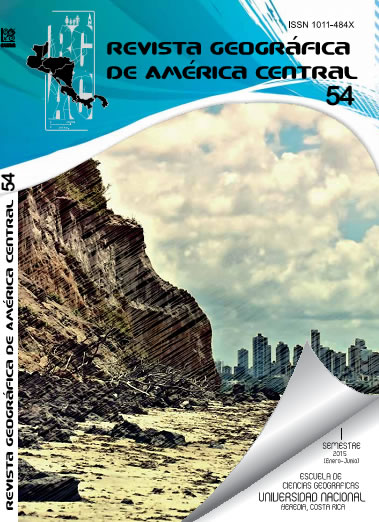POTENTIAL DISTRIBUTION OF Musa velutina (MUSACEAE) IN PROTECTED WILD AREAS OF COSTA RICA
DOI:
https://doi.org/10.15359/rgac.1-54.8Keywords:
Musa velutina, probability, potential distributionAbstract
By using the maximum entropy algorithm (MaxEnt) model, this study determined which protected wild areas are suitable habitats for Musa velutina. The variables used were biotemperature, precipitation, humidity, and the altitude level obtained from the 2008 atlas of the Costa Rican Technological Institute (TEC, for its name in Spanish). The model shows good performance according to the area under the curve (AUC = 0.824). Areas with higher levels of suitable habitats were located in moderate elevation levels on the Caribbean slope. When the contribution of variables were analyzed, the largest contributor to the model was biotemperature. M.velutina is widely distributed in many protected areas in Costa Rica, which can be an ideal environment for their establishment and high potential to become invasive. This model of potential species distribution is of great value when generating strategies for a more efficient use of resources and for predicting potential scenarios. This knowledge allows increasing success in conservation projects and management.References
Barquero, K. (2005). Musa velutina en La Selva: dispersión de una especie exótica. Ecología Tropical y Conservación, 1 (2): 184-186.
Bradley, B., Wilcove, D. & Oppenheimer, M. (2010). Climate change increases risk of plant invasion in the Eastern United States. Biological Invasions, 12 (6), 1855-1872.
Chacón, E. (2009). Las plantas invasoras en Costa Rica: ¿Cuáles acciones debemos realizar? Biocenosis, 22, 1-2.
Lacoste, A. & Salanon, R. (1973). Biogeografía. Barcelona: Oikos-tau.
Morales, N. (2012). Modelos de distribución de especies: Software Maxent y sus aplicaciones en Conservación. Conservación Ambiental, 2 (1).
Morera, B. & Granados, A. (2013). Distribución y abundancia de Musa velutina en un bosque nuboso, Ángeles de San Ramón, Alajuela, Costa Rica. Red Latinoamericana para el Estudio de Especies Invasoras, 3, 16-22.
Morera, J. & Umaña, C. (1995). Programa Agricultura Tropical Sostenible Unidad Recursos Filogenéticos. Jardín Botánico Cabiria-7. Recuperado de http://orton.catie.ac.cr/repdoc/A4180E/A4180E.PDF
Pearson, R. (2007). Species distribution modeling for conservation educators and practitioners. Synthesis. American Museum of Natural History. Recuperado de: http://ncep.amnh.org
Quirós, R. (2014). Encargado de Investigación OTS Las Cruces. Comunicación personal, 11 de mayo de 2014.
Rojas, F., Cruz, G., & Madrigal, Q. (2006). Plantas ornamentales del trópico. Editorial Tecnológica de CR.
Sandoval, I., Carrillo, E., & Sáenz, J. (2011). Modelo de hábitat potencial para el jaguar, Panthera onca (Carnivora: Felidae), en la península de Osa Costa Rica. BRENESIA 75-76: 90-96
Savino, C., Diodato L., Gatto M. A. & Zerda H. (2013). Modelación espacial de especies, género Dactylopius, Región Parque Chaqueño Seco. En IV Jornadas Tucumán SIG. CD ISSN 2250-6977.
Sheela, V. (2008). Flowers for Trade. New India Publishing Agency, New Delhi, India.
Siles, G., Bastida, J., Rey, P. & Alcán, J. (2005). Modelos predictivos de distribución de especies de vegetación potencial en el incendio del “Puerto de las Palomas, Sierra de Cazorla”, Jaen. Cuadernos de la SECF, (20).
Swets, J. (1988). Measuring the accuracy of diagnostic systems. Science, 240(4857), 1285-1293.
Urbina-Cardona, J. & Castro, F. (2010). Distribución Actual y Futura de Anfiios y Reptiles con Potencial Invasor en Colombia: Una Aproximación Usando Modelos de Nicho Ecológico. Biodiversidad y Cambio Climático, Bogota, Colombia.
Wendlan, H. & Drude, G. (1875). Musa velutina, Gartenflra 65, t. 823.
Wisz, M., Hijmans, R., Li, J., Peterson, A., Graham, C. & Guisan, A. (2008). Effects of sample size on the performance of species distribution models. Diversity and Distributions, 14 (5), 763-773.
Downloads
Published
How to Cite
Issue
Section
License
Proposed policy for journals offering Open Access
Authors publishing their works in the Journal acknowledge and agree to the following terms:
a) Authors retain the copyrights to their works and guarantee the Journal the right to be the first to publish their works, under the Creative Commons License Attribution-NonCommercial-ShareAlike 4.0 International, CC BY-NC-SA 4.0 International (https://creativecommons.org/licenses/by-nc-sa/4.0/deed.es), which allows others to share works upon complying with the acknowledgment of authorship and mention of the Journal as the original publisher of the work.
b) Authors are permitted to separately establish additional agreements for the non-exclusive distribution of the official edition of the work published in the Journal (for example, authors may desire to place the work in an institutional repository or incorporate it into a book that is to published elsewhere) so long they acknowledgment to recognize the Journal as the original publisher. The aforementioned additional agreements must respect the terms of the non-profit character and sharing philosophy of the original license (CC BY-NC-SA 4.0 International, https://creativecommons.org/licenses/by-nc-sa/4.0/deed.es).
c) Authors are encouraged to archive the post-print or editor/PDF version in Open Access repositories.






 REVGEO is licensed under https://creativecommons.org/licenses/by-nc-sa/4.0/deed.es
REVGEO is licensed under https://creativecommons.org/licenses/by-nc-sa/4.0/deed.es
.svg_4.png)

_(1).png)
_(1)_(1)_(1)_1.png)
(2)(1)(1)(1).png)
